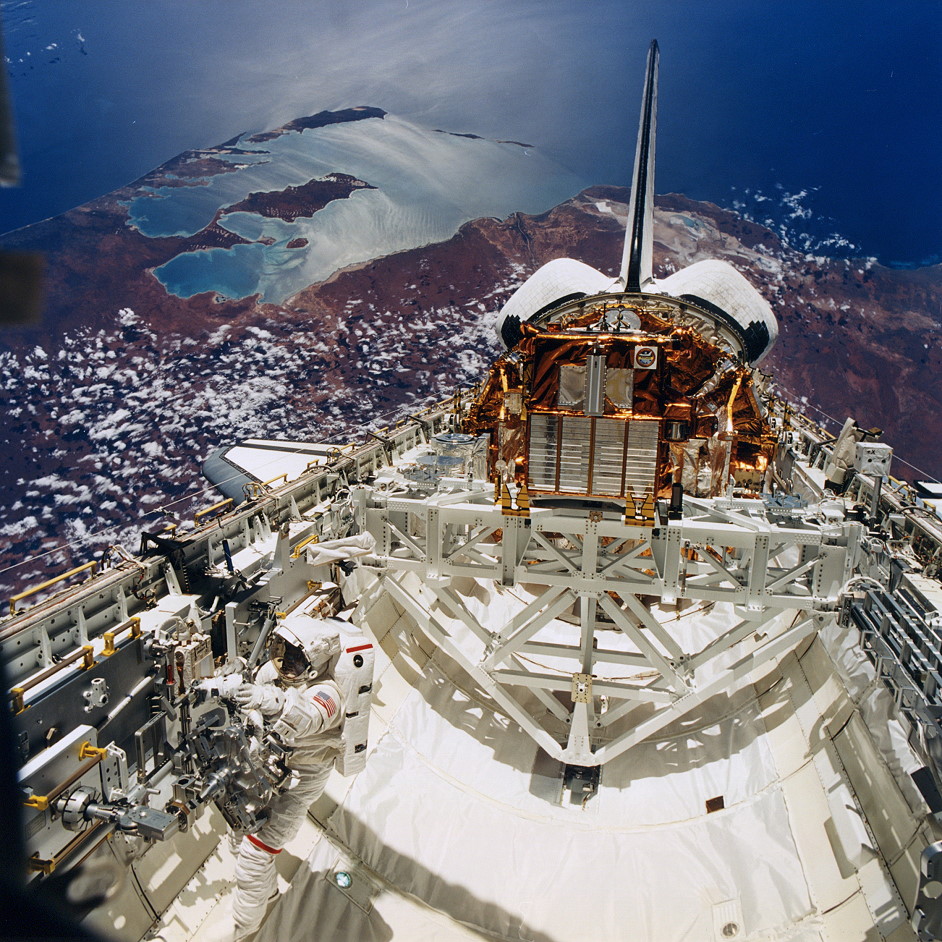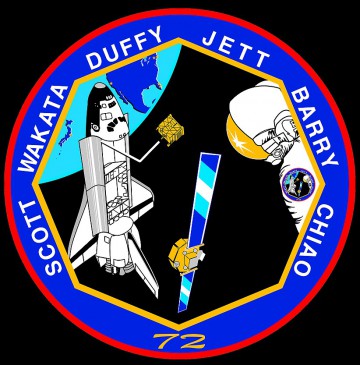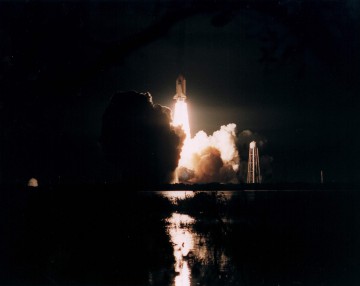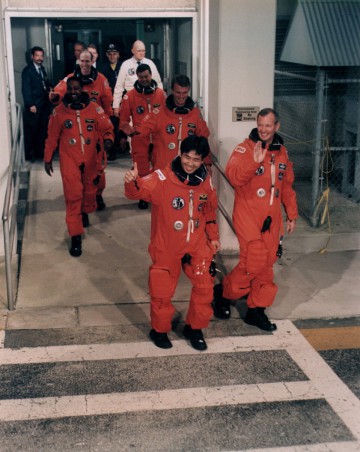
Almost two decades ago, six astronauts rocketed into the night on a mission which put virtually all of the shuttle’s capabilities—satellite deployment and retrieval, rendezvous and proximity operations, research, and spacewalking—to the test, as well as providing a great insight into the work that NASA would require to build the International Space Station (ISS). STS-72, launched aboard Endeavour on 11 January 1996, was tasked with capturing a Japanese spacecraft, after 10 months in orbit, as well as deploying and retrieving a small free-flying satellite and evaluating tools for ISS assembly and maintenance.
Endeavour’s six-man crew—Commander Brian Duffy, Pilot Brent Jett, and Mission Specialists Leroy Chiao, Winston Scott, Dan Barry, and Japan’s Koichi Wakata—had been assigned more than a year earlier, in December 1994. Wakata was the first Japanese citizen ever selected by NASA for Mission Specialist training and, in time, he would go on to fly two long-duration ISS expeditions and become the first of his countrymen to command the multi-national outpost. His assignment to STS-72 came about partly because the nine-day mission would retrieve Japan’s Space Flyer Unit (SFU) from low-Earth orbit.
This 7,900-pound (3,580-kg), octagonal-shaped satellite had been launched by the National Space Development Agency of Japan (NASDA), atop a H-II booster from the Tanegashima Space Centre on 18 March 1995, carrying a range of autonomous experiments in materials science, space biology, engineering, and astronomy. In additional to key involvement from NASDA—which, in October 2003, became today’s Japan Aerospace Exploration Agency (JAXA)—the SFU program also featured co-operation from the Institute of Astronautical Science (ISAS) and the Ministry of International Trade and Industry. Its objectives includes providing researchers will a suite of long-duration facilities on a reusable spacecraft, which, it was hoped, would fly at least twice.

Aboard the SFU were the Infrared Telescope in Space (IRTS) to explore the Universe and the structure of the Milky Way Galaxy, the Space Plasma Diagnostics Package (SPDP) and several other payloads to to evaluate the assembly of large structures and high-voltage solar arrays in space, to demonstrate electric propulsion and fuel-management technologies, to observe the behaviour of liquids in the microgravity environment, and to monitor the hatching and evolution of eggs in space. After retrieval by the STS-72 crew, it was intended that the SFU would be serviced and readied for a second mission. However, none of NASA’s shuttle manifests from 1992-1997 featured a second retrieval flight, and after STS-72 the SFU never flew again. Today it is housed in Tokyo’s National Museum of Nature and Science.
Commander Brian Duffy brought a great deal of expertise to the SFU retrieval effort, for he had previously served as pilot aboard STS-57 in June 1993, which recovered the European Retrievable Carrier (EURECA) satellite from orbit after ten months and brought it back to Earth. Accomplishing the rendezvous demanded a very precise liftoff from Pad 39B at the Kennedy Space Center (KSC) in Florida, timed to occur within a 49.5-minute “window,” which extended from 4:18 a.m. until 5:07:30 a.m. EST on 11 January 1996. The launch would thus position Endeavour onto a course to continually close the distance to the SFU, setting the astronauts up to conduct the retrieval about 48 hours into their mission.
The STS-72 countdown operations began on 8 January, tracking an on-time liftoff on the 11th. Early on launch morning, the six-man crew suited-up and boarded Endeavour for a relatively smooth final couple of hours, punctuated only by minor problems with facilities or ground servicing equipment. Shortly before the countdown entered a planned, built-in hold at T-20 minutes, it became clear that the shuttle’s main engines were running a little cool and the flow of gaseous nitrogen was adjusted. Later, a communications configuration glitch was detected between Mission Control at the Johnson Space Center (JSC) in Houston, Texas, and ground stations at KSC, prompting a 23-minute delay into the first half of the launch window. None of these problems prevented Endeavour from rocketing into the darkened sky at 4:41 a.m. EST, turning night into day across the marshy Florida landscape, and reaching a preliminary orbit just nine minutes later.

At the point of orbital insertion, Endeavour trailed the SFU by 9,160 miles (14,740 km), closing this distance by up to about 860 miles (1,390 km) during each circuit of Earth, and the crew spent their first day in space checking out their rendezvous tools and equipment. With Wakata designated as the primary operator of the shuttle’s Remote Manipulator System (RMS), he was responsible for powering up and testing the Canadian-built mechanical arm, whilst Duffy carried out tests of controls on the aft flight deck. Other crew members also activated numerous of STS-72’s secondary payloads, including protein crystal growth studies on the middeck, two Getaway Special (GAS) experiments to explore the influence of vibrations on a pair of cantilevered flexible beams and grow crystals of the horse heart myoglobin, and bovine pancreatic ribonuclease S proteins in the payload bay and the Shuttle Laser Altimeter (SLA). The latter was making its first flight and was designed to measure the distance between Earth’s surface and the orbiting shuttle, transmitting a series of short laser pulses and precisely measuring the reflected echoes from land, ocean, vegetation, and cloud-tops.
By the evening of 11 January, halfway through the first day of the mission, Endeavour had continued to reduce the distance between herself and the SFU. The Japanese flight controllers verified that their satellite was in good shape, despite having lost functionality in two reaction-control thrusters, which were not considered a threat to the retrieval. Early on the 12th, Duffy and Brent Jett pulsed the shuttle’s Reaction Control System (RCS) thrusters to slightly adjust their orbit and avoid an unwanted close encounter with the U.S. Air Force’s MISTY military satellite. Had they not taken the action, it was estimated that Endeavour would have passed within an uncomfortably close 0.7 miles (1.2 km) of the dead satellite. As circumstances transpired, the two spacecraft passed within 5 miles (8 km) of each other. By that evening, following another orbit-raising maneuver, the shuttle was just 300 miles (480 km) behind the SFU, closing at a slower rate of about 60 miles (96 km) per orbit.

The final rendezvous in the early hours of 13 January began about three hours ahead of the scheduled retrieval, with a Terminal Initiation (TI) burn of Endeavour’s RCS thrusters, at which stage she was about 9.1 miles (14.8 km) from her quarry. The shuttle approached the SFU along the so-called “R-Bar” corridor, tracing an imaginary line directly “upwards” from the centre of Earth to reach the SFU. At this stage, Wakata powered up the RMS and extended it high above the payload bay, ready to capture the satellite. As they drew to within about a half-mile (0.8 km) of each other, about 90 minutes ahead of the scheduled 4:26 a.m. EST retrieval, the shuttle’s rendezvous radar locked onto the SFU. With a constant stream of range and rate-of-closure data at his disposal, Duffy assumed manual control of the orbiter.
Drawing nearer, at 590 feet (180 meters), he switched the shuttle’s RCS to “Low-Z” mode, which employed offset thrusters in the nose and tail for braking, rather than risking contamination by using the thrusters facing directly toward the satellite. During this period, range and rate-of-closure data was provided by Leroy Chiao, courtesy of a hand-held laser ranging device. By the time Endeavour reached about 147 feet (45 meters) from the SFU, he entered a 45-minute station-keeping phase as the Japanese flight controllers began to command the satellite’s twin solar arrays to close and latch into place.
It was during these activities that STS-72’s first gremlin reared its head.
The second part of this article will appear tomorrow.
Want to keep up-to-date with all things space? Be sure to “Like” AmericaSpace on Facebook and follow us on Twitter: @AmericaSpace



